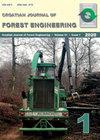用于捷克收获机木材体积估算的欧洲常见阔叶树种的双层树皮厚度估算模型
IF 2.1
2区 农林科学
Q1 FORESTRY
引用次数: 0
摘要
在过去几十年中,收割机生产的木材在捷克森林生物经济中的年产量份额有所增加。为了估计树皮下的木材体积,收割机系统允许在两种不同的树皮推断模型之间进行选择——直径带(DBM)和线性模型。然而,线性模型没有针对捷克林业的条件进行校准。因此,本研究的目的是根据捷克的当地条件,开发用于估计两组阔叶树种(山毛榉和橡树)的双层树皮厚度的线性函数,并根据实际收获数据测试其可行性。为了创建线性函数,使用了捷克官方的立方表。从15台收割机上收集了实际收获的数据。使用描述性统计和成对Wilcoxon检验对包含属于山毛榉组的4995根原木的样本进行分析。山毛榉组的平均双层树皮厚度为15.1mm(多项式和线性模型)。橡树组为15.48毫米(多项式)或15.49毫米(线性)。山毛榉组的实际收获结果显示,多项式函数估计的平均双层树皮厚度为7.08mm。线性函数估计值比DBM估计值(6.68mm)更接近多项式估计值(6.84mm)。因此,我们可以说,新开发的线性模型可以用于全面机械化收割,而不是捷克的人工树皮推导方法。本文章由计算机程序翻译,如有差异,请以英文原文为准。
Double Bark Thickness Estimation Models of Common European Broadleaved Species for Harvester Timber Volume Estimation in Czechia
The share of the annual volume of harvester-produced timber in Czech forest bioeconomy has increased in the last decades. To estimate under-bark timber volume, harvester systems allow choosing between two different bark deduction models – diameter band (DBM) and linear model. However, linear models were not calibrated for the conditions of Czech forestry. Therefore, the objective of this research was to develop, for local conditions in Czechia, linear functions for estimating the double bark thickness of two groups of broadleaved species (beech and oak) and to test their viability based on real harvest data. To create the linear functions, official Czech cubing tables were used. Data from real harvests were gathered from fifteen harvesters. A sample containing 4995 logs belonging to the beech group was analyzed using descriptive statistics and the Paired Wilcoxon tests. The mean double bark thickness for beech group was 15.1 mm (polynomial and linear model). For oak group, it was 15.48 mm (polynomial) or 15.49 mm (linear). The results of real harvests for beech group revealed that the mean double bark thickness estimated by the polynomial function was 7.08 mm. The linear function estimates were closer to the value estimated by the polynomial (6.84 mm) than DBM estimates (6.68 mm). Therefore, we can state that the newly developed linear models can be used in fully mechanized harvesting instead of manual bark deduction methods in Czechia.
求助全文
通过发布文献求助,成功后即可免费获取论文全文。
去求助
来源期刊
CiteScore
5.20
自引率
12.50%
发文量
23
审稿时长
>12 weeks
期刊介绍:
Croatian Journal of Forest Engineering (CROJFE) is a refereed journal distributed internationally, publishing original research articles concerning forest engineering, both theoretical and empirical. The journal covers all aspects of forest engineering research, ranging from basic to applied subjects. In addition to research articles, preliminary research notes and subject reviews are published.
Journal Subjects and Fields:
-Harvesting systems and technologies-
Forest biomass and carbon sequestration-
Forest road network planning, management and construction-
System organization and forest operations-
IT technologies and remote sensing-
Engineering in urban forestry-
Vehicle/machine design and evaluation-
Modelling and sustainable management-
Eco-efficient technologies in forestry-
Ergonomics and work safety

 求助内容:
求助内容: 应助结果提醒方式:
应助结果提醒方式:


